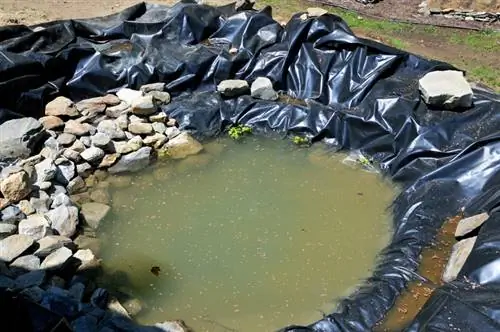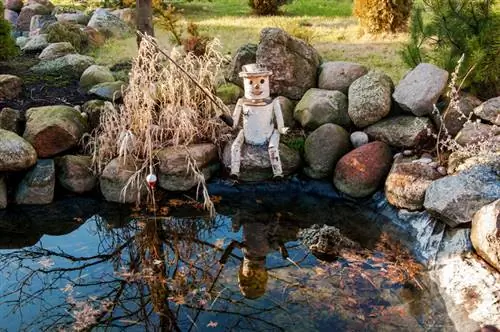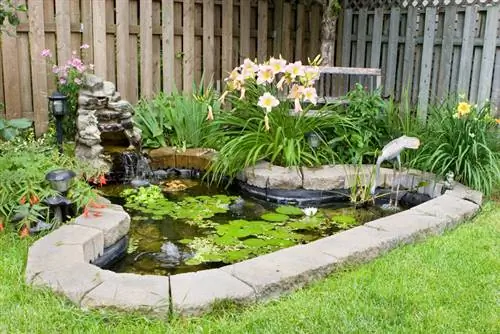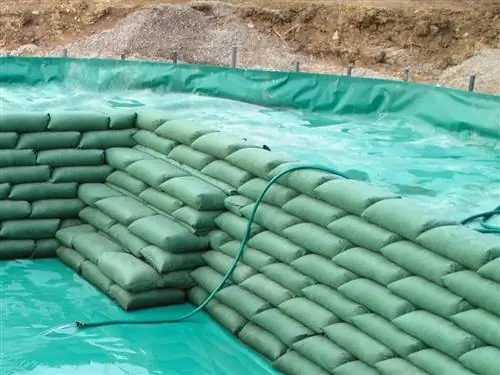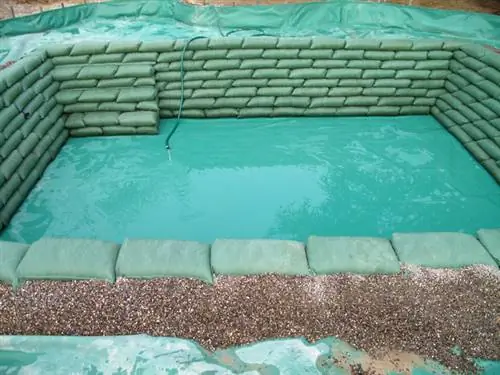- Author admin [email protected].
- Public 2023-12-16 16:46.
- Last modified 2025-06-01 06:02.
A garden pond is often a do-it-yourself project - and can easily be done yourself. However, you should always pay attention to a few things. The professional installation of the film is important because the subsequent tightness and lifespan of the film depends on this. Read how to do it correctly here.
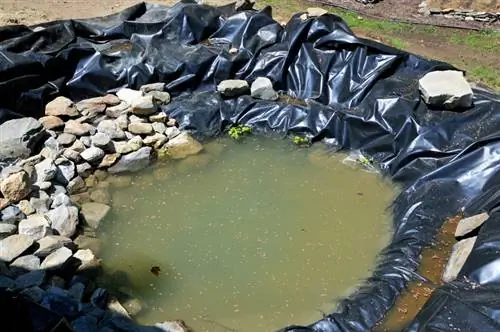
How do you lay pond liner correctly?
To lay the pond liner correctly, first prepare a layer of sand and a pond fleece. With the help of helpers, lay out the film without wrinkles, partially fill the pond with water and weigh down the edges. Let it sit for a day, fill the pond completely and create a capillary barrier.
Plan pond liner
First you have to decide on a specific type of slide - we'll give you a little help in this article.
Once you have selected the film material that is right for you, you must determine and order the required size (length and width) of the film. Calculating the liner size can be quite a challenge, depending on how complicated the pond shape is. We explain in detail how it works and how to calculate correctly in this special article.
You can then order the film from the manufacturer. When it is delivered, you can start laying it.
Observe outside temperature
It is best to always lay the films in summer. At low temperatures, most films are less flexible and stretchable and are therefore significantly more difficult to lay.
In addition, the brittleness that PVC films have in the cold can cause the film to tear when it is being laid. Such damage is more than annoying when the pond that has just been completed has to be repaired later.
Important when laying
There are a few things you should pay attention to when laying:
- First, familiarize yourself with how the film is rolled or folded when it is delivered.
- Wear suitable footwear when laying (rounded rubber soles in which no stones can get stuck, if in doubt it is better to go barefoot)
- Make sure that there are no tensions or tensile loads on the film when laying, this must be avoided at all costs.
Laying pond liner - step-by-step instructions
- Pond Liner
- Sand
- Pond fleece, cut to size
- Gravel for patio steps
- Gravel for capillary barrier
- Stones to weigh down the film in the edge area
- Helpers (always recommended, essential for larger ponds, 1 helper per 100 m² of film)
- Calculations
- Spade
1. Prepare pond liner
Take the pond liner made by the manufacturer to the edge of the planned pond at a corner of the pond. Check to see if there are any special installation instructions from the manufacturer. There are many such instructions - you should always follow them exactly.
2. Prepare underlayers
First, always create any cable ducts you may need at the bottom of the pond. Then apply a layer of sand about 5 cm thick. This layer effectively protects the film from damage later and should have been taken into account in the planning.
Now lay out the pond fleece on the smooth layer of sand. It must be absolutely wrinkle-free, pay attention to this. Then attach the pond fleece to the edges so that it cannot slip when the foil is placed over it.
3. Laying foil
Work with the helpers to unfold the foil from the edge into the pit. Always fold folds together into a larger fold and fold it over. Fill the pond about a third full with water to weigh down the liner and place pebbles on any terrace steps. This pushes the film deeper into the pond. Leave like this for at least a day. The edges of the film must be weighted.
4. Finish the pond
Fill the pond completely. Once the water is filled, you can begin to create the capillary barrier. Build a mound about 10 cm high around the edge of the pond and an equally deep ditch behind it. Pull the edges of the foil over the hill into the ditch and attach them there (for example between two stones). Fill the trench with gravel. You may also be able to attach a bank or embankment mat over the foil.
Tip
Terraces, peninsulas and especially terrace corners often cause real difficulties when laying the pond liner. If you build a pond yourself, it is better to avoid such complicated structures, unless there is no other way.

